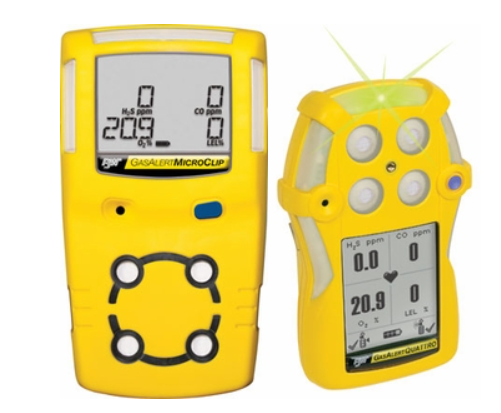
When considering work in confined spaces or around dangerous gases, it is important to have gas detectors present so that dangerous levels of gases can be detected. This helps you make informed decisions about whether to start work, and in the event of a problem, providing time for workers to get to safety. With so many choices in gas detection, it may be difficult to choose the right unit for you. Here is a recent question we recently received.
"I am interested in purchasing a 4-gas monitor. I am looking at the Honeywell Gas Alert Quattro and Honeywell Gas Alert Micro Clip XT. I had a few questions about the models. Do the standard monitor settings meet OSHA standards or we do not have to program the standard gas levels into the device?"
Both of these units come pre-programmed with OSHA alarm levels, though these can be modified if you want stricter settings. In fact, all of the gas detectors we sell for confined space entry have these alarm limits built in.
Once gas levels reach the set threshold, the units will alarm. Each unit will alarm in 3 ways, lights, beeps and vibration to ensure that you are aware of the change in gas levels.
Do the monitors detect all of the gases constantly?
Yes, all 4 gases are constantly monitored, and all 4 are constantly displayed on both the Quattro and the Micro Clip.
I noticed that there is an alkaline Quattro and Micro Clip XT and there is also a rechargeable version of each. Do they plug into the wall to recharge or do they require batteries?
The ones we stock and sell are rechargeable. They come with the rechargeable batteries already installed, and 110VAC wall charger. As an accessory, we also sell a 12VDC vehicle charging adapter.
What are some of the similarities and differences between the two models?
The Quattro is a little larger physically, and more robust, while the Micro Clip is smaller, lighter and cheaper. They are functionally the same. Each has 4 sensors, is diffusion based, and is rechargeable. Some clients are focused on longevity, and the Quattro fills that bill nicely. Others are more focused on price, and this is where the Micro Clip comes in.
Do the devices have to be calibrated within a certain time frame?
That is a controversial subject. OSHA would have you calibrate it before each use. In practice, our customers come up with their own intervals. If the unit is used infrequently, say once a month, it should be calibrated every time. If you use it a few times a week, then maybe an occasional bump test will be enough to allow you to calibrate less often. The idea is to make sure the unit is working properly. It is important to remember that these units are protecting your life. They are very stable, but test gas is really the only way to be sure they are calibrated correctly.
If you are looking for a 4-gas diffusion monitor, the BW Quattro and the Honeywell Gas Alert Micro Clip XT are among the top sellers in the market. We sell lots of these monitors each month, and they seem to make our customers very happy.
If you are looking into getting a gas detector we love both BW Honeywell and RAE Systems. Between the two brands, gas sniffer performance is about the same. Sensor technology is the limiting factor, and all brands are more or less on the same page there. Reliability is pretty good across all these brands. There can be hiccups with any of them for sure, but don't forget that these are complex devices, intended for use by trained professionals. If you have any questions about which gas detector would be right for your job, feel free to contact us and ask.
